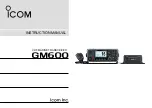
SWRS046H – NOVEMBER 2006 – REVISED MARCH 2015
Figure 5-11. Typical RSSI Value vs Input Power for Some
Figure 5-12. Typical RSSI Value vs Input Power for Some
Typical Channel Spacings, 433 MHz
Typical Channel Spacings, 868 MHz
5.9.6
Image Rejection Calibration
For perfect image rejection, the phase and gain of the “I” and “Q” parts of the analog RX chain must be
perfectly matched. To improve the image rejection, the “I” and “Q” phase and gain difference can be fine-
tuned by adjusting the PHASE_COMP and GAIN_COMP registers. This allows compensation for process
variations and other nonidealities. The calibration is done by injecting a signal at the image frequency, and
adjusting the phase and gain difference for minimum RSSI value.
During image rejection calibration, an unmodulated carrier should be applied at the image frequency
(614.4 kHz below the desired channel). No signal should be present in the desired channel. The signal
level should be 50 to 60 dB above the sensitivity in the desired channel, but the optimum level will vary
from application to application. Too large input level gives poor results due to limited linearity in the analog
IF chain, while too low input level gives poor results due to the receiver noise floor.
For best RSSI accuracy, use AGC_AVG[1:0] = 11 during image rejection calibration (RSSI value is
averaged over 16 filter output samples). The RSSI register update rate then equals the receiver channel
bandwidth (set in FILTER register) divided by 8, as the filter output rate is twice the receiver channel
bandwidth. This gives the minimum waiting time between RSSI register reads (0.5 ms is used below). TI
recommends the following image calibration procedure:
1. Define 3 variables: XP = 0, XG = 0 and DX = 64. Go to step 3.
2. Set DX = DX/2.
3. Write XG to GAIN_COMP register.
4.
If XP + 2 × DX < 127, then
write XP + 2 × DX to PHASE_COMP register
else
write 127 to PHASE_COMP register.
5. Wait at least 3 ms. Measure signal strength Y4 as filtered average of 8 reads from RSSI register with
0.5 ms of delay between each RSSI read.
6. Write XP+DX to PHASE_COMP register.
7. Wait at least 3 ms. Measure signal strength Y3 as filtered average of 8 reads from RSSI register with
0.5 ms of delay between each RSSI read.
8. Write XP to PHASE_COMP register.
9. Wait at least 3 ms. Measure signal strength Y2 as filtered average of 8 reads from RSSI register with
0.5 ms of delay between each RSSI read.
10. Write XP-DX to PHASE_COMP register.
11. Wait at least 3 ms. Measure signal strength Y1 as filtered average of 8 reads from RSSI register with
32
Detailed Description
Copyright © 2006–2015, Texas Instruments Incorporated
Product Folder Links:
















































